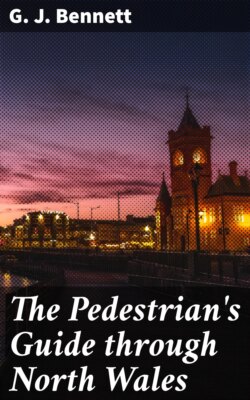Читать книгу The Pedestrian's Guide through North Wales - G. J. Bennett - Страница 14
На сайте Литреса книга снята с продажи.
CHIRK CASTLE
ОглавлениеTable of Contents
Is delightfully situated on the spacious domain, spreading over the summit of, what would be deemed, by a southern, a lofty mountain, but which is here only designated a hill, projecting from the range of Berwyn mountains; and is well calculated to recall the stories of the days of old, when flourished
“The good old rule, the simple plan,
That they should take who have the power,
And they should keep who can.”
It is built of solid stone; and the ivy, mantling over the walls, gives them an appearance of solemnity and grandeur, peculiarly interesting. It is quadrangular, and is strengthened by five massive towers, one at each corner, and the fifth projecting from the principal front, through which is a lofty entrance into the court-yard, 165 feet in length, and 100 feet in breadth, surrounded on every side by noble suites of apartments. The picture gallery measures 100 feet in length, by twenty-two in breadth; and contains some very excellent paintings, and several portraits of the Middleton family. Amongst the latter is that of Sir Thomas Middleton, who defended himself gallantly against the forces of Cromwell, and was rewarded for his loyalty by Charles II, who granted him £30,000 for the loss he had sustained, besides many valuable presents; amongst others, a cabinet, which is shewn in the gallery, valued at £7,000, richly ornamented with silver; in various compartments of which are paintings, said to have been executed by Rubens. The monarch offered to elevate Sir Thomas to the peerage, which he declined.
The walls of the castle are eighteen feet in thickness; but sleeping and other apartments have been cut into them, for the accommodation of the family.
The celebrated picture of Pystil Rhaidar, in the dining-room, shows that noble waterfall tumbling into the sea, where several ships are quietly riding at anchor. “Pystil Rhaidar,” i.e. “The spout of the Cataract,” is considered the largest fall in Wales. In the valley of Mochnant, about four miles from the village, the river falls over an almost perpendicular rock, 240 feet high; thence rushing furiously under a natural arch towards the bottom, it plunges into a deep black pool, overhung with impervious shaggy wood.
The story of the artist’s introducing the ocean with ships, is rather curious. He was a foreigner, and but little acquainted with the English language; and when he had completed the picture, one of the persons to whom it was first shown observed, that “a few sheep placed near the foot of the fall would be a great improvement.” Misunderstanding sheep for ship, his amazement was extreme. He, however, took the picture to his easel, and introduced ships with the necessary element to float them! A mistake so humorous determined the purchaser to allow of no further alteration.
The present building was completed in two years. The first stone being laid in the year 1011, and in 1013 the castle frowned defiance to the foe.
It was built by Roger Mortimer, Earl of Wigmore, as a stronghold to defend him from the just vengeance he had created by the murder of the sons of Gryffydd ap Madoc, to whom he was appointed guardian, in conjunction with John, Earl of Warren, in the hope of inheriting their joint estates. Mortimer was to seize upon Nanheuddwg and Chirk, the property of the youngest; and Warren upon the lands of Broomfield, Yale, and Dinas Bran, belonging to the eldest. Travellers should not neglect to visit this noble specimen of warlike architecture. Its picture gallery and dungeon will, in their different styles, excite admiration.
On the foundation of the present castle anciently stood Castle Crogen; and the territory around bore the name of Tref-y-Waun, the property of the lords of Dinas Bran, and continued in their possession up to the death of Gryffydd ap Madoc, in the reign of Edward the First.
The view from the highlands of the park is very extensive, commanding a prospect of seventeen different counties. “The ground upon which we now stand,” said my companion, “is remarkable for a melancholy circumstance, which caused much grief and sorrow in the castle and its neighbourhood. The story of Owen-ap-Mylton and Mary Fuller will perhaps interest you, as it gave a name to this part of the estate, which it still retains, ‘The Black Park.’”
